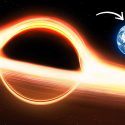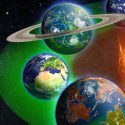This is the Universe. And this little dot here is the Earth. And this is a Big Bounce coming up, and it’s about to squash our planet. Yikes.
How long would we have untill the Earth got crushed into nothingness? What would we observe from down here? And what would happen next?
It’s generally accepted that the Universe emerged from one single point of infinite density, and then rapidly expanded in what we call the Big Bang. But when it happened, nobody was around to see it for themselves.
So here comes a new theory. What if it all didn’t start with the Big Bang 13.8 billion years ago?
What if, instead, the Universe had no beginning and no end, but was expanding and contracting back over and over again?
The cyclic Universe involves a series of Big Bounces, where the Universe acts like an enormous cosmic lung, inhaling and exhaling a giant breath with every bounce. Basically, you’ve got nothing to worry about. Because the cyclic Universe expands for several billion years, and then contracts for billions of years. On a scale of a human lifespan, this timeline is just not developing fast enough to affect you in any way.
But we here at WHAT IF like to add some spice to our stories. In this case, we’ll speed things up, and have the Universe go through its bouncing cycle almost every day. And the next bouncing event is scheduled for tomorrow.
You’d start the day with some worrisome news from astrophysicists. The stars and galaxies, that normally move slowly away from each other, would now be moving toward one another. And fast.
Every planet, star, and every galaxy on the edge of the Universe would be rushing towards its center, breaking the cosmic light speed limit. Black holes would be colliding with other black holes. They’d be sending huge amounts of cosmic radiation in all directions, and growing into even bigger black holes.
No planet in the Universe would have a stable orbit anymore. They’d go flying across the galaxy to meet up at the cosmic “downtown.”
At this point, things would get quite messy on our planet. And you wouldn’t be able to do a thing to stop it. So just sit back, and watch the world end.
As the Universe continued to collapse in on itself, its temperature would rapidly become hotter. The superheated temperatures would evaporate our oceans, our planet, and even our atoms. Everything that ever existed would be wiped out.
Finally, when the Universe contracted to its densest point, it would become a superhot, dense mix of matter. It would slow down for a moment, and then suddenly start expanding again. A new bouncing cycle would begin. A totally new Universe would emerge.
New Universe, old rules. From hot cosmic dust, gravity would form new planets, new stars and new galaxies. And then new lifeforms would emerge on those new worlds.
This new Universe would expand until it reached its limit. And then it would go back to becoming a dense, hot ball of matter.
The cycle would repeat. And again. And again. But we would be too long gone to know about it.
Well, that turned out a bit dark. But hey, the Universe is only 13.8 billion years old. We’ve got a few billion more until the contraction could begin.
Sources
- “Forget the Big Bang, our universe may have formed from a Big”. Woollaston, Victoria. 2020. WIRED UK.
- “What If The Big Bang Was Actually A Big Bounce?”. Wood, Charlie. 2020. Wired.
- “Dark Energy”. 2020. hyperphysics.phy-astr.gsu.edu.
- “Solved: The mystery of the expansion of the universe”. 2020. phys.org.
- “Hubble Law And The Expanding Universe”. 2020. hyperphysics.phy-astr.gsu.edu.
- “Did the Universe Boot Up with a “Big Bounce?””. Moskowitz, Clara. 2016. Scientific American.
- “Ask Ethan: Could The Universe Have Begun From A Big Bounce?”. Siegel, Ethan. 2020. Forbes.



























